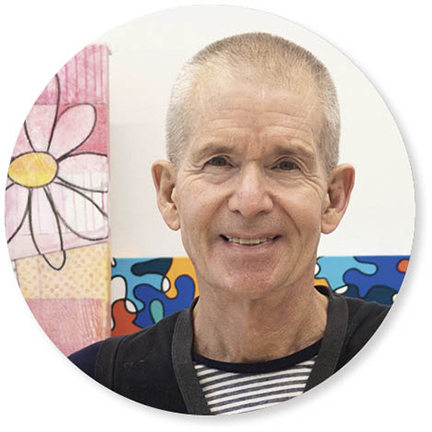
artist SPOTLIGHT / Murray Archibald
I’ve hounded this beloved member of our community to speak of his art for years—and he finally agreed!
Doug Yetter: Is there a time of day when you feel more creative?
Murray Archibald: Not really. Creativity doesn’t turn on and off. It’s always present. The trick is to control the noise around us, so we don’t miss that little piece of a thought or a concept that completes an idea. We must listen—to our heart, to our mind, to the people in our lives, and to the world around us.
DY: Do you have a favorite medium?
MA: Most of my work is acrylic. My early work was airbrush/acrylic. Currently I am mainly working with acrylic gouache, acrylic mediums and textures, and watercolor.
DY: I’m certain there’s a huge difference between the amount of creative time available in your years with CAMP Rehoboth and your life now. How has that changed?
MA: When we founded CAMP Rehoboth in 1990, I was creating a one-man exhibition every year. My intention was to continue along that path, while doing whatever was needed to nurture our young and growing organization. I managed to create new exhibitions for most of the first decade, but by 2005 the workload had grown too heavy. I made a choice to put my annual art shows on hold so I could concentrate on CAMP Rehoboth.

DY: Did the pandemic affect your art, or how you think about art?
MA: By the time the pandemic hit us in 2020, I had already stepped back from my leadership position at CAMP Rehoboth and moved my office to my studio. Though I was still doing a little freelance work for CAMP—including the 2020 virtual Sundance—I was excited about my return to the studio. Over the next year of the pandemic, I created the LOCKDOWN 2020 Series, exploring pandemic related ideas.
DY: Where did you receive your training?
MA: In my youth, I took art classes, but my passion in those days was theatre, and that was my major. Along the way, I continued to design and create art and graphics especially for the theatre. My theatre background was extremely helpful in designing the many events we produced over the years—especially Sundance. It was the early 1980s when I made the decision to focus on my art.
DY: How has your work evolved over the years?
MA: I used an airbrush for my early work, and painted flowers as a means of improving my skill with that tool—and because they sold well. In the decades that followed, I added new painting techniques with more texture, color, and pattern.
Thematically, I have always painted from the heart, and the heart remains a key component of my work—as does healing (red cross), transformation (butterflies), vision (eyes and open windows), and creativity (spirals). From the mid-1980s through the 1990s, the red AIDS ribbon was often prominent in my work, especially in the large pieces I created for Sundance.
Echoing my CAMP Rehoboth concept of “creating a more positive” world, my art attempted to do the same thing. Exhibition titles included: Change Is, Awakening, Lifedance, Emergence, Resurrection, and Colors of the Heart, to name a few.
DY: What can we expect from your new show at CAMP?
MA: My new exhibition—Mask Hysteria—contains three different series. The LOCKDOWN 2020 Series is a collection of small paintings created during the first year and half of the pandemic. They are more abstract and darker than my earlier work, and while they certainly address pandemic themes, they also served as a means of developing new paining techniques before moving onto the larger pieces I’m doing now. The pandemic mask is prominent in that series, and facial imagery is all about the eyes.
In the HeartSCAPE Series, the work is larger, and while not as directly connected to the pandemic, it continues to explore that which is hidden (masked) from ourselves and from each other.
The final series, titled InterACTION is more conceptual with intersecting shapes representing the “viral” nature of life—both biological and virtual.
DY: Were there themes you wanted to explore, or did they evolve as part of your process?

MA: All my favorite themes continue to be present in my new work, especially the heart. Purple Heart (Dream) is a call for us to find ways of putting aside our differences—especially our political polarization. The Red Vase is literal, but also a symbol of the heart. The Kiss is more about physical love. Imagine the moment right before a first kiss. There is also doubt in that moment.
The world is chaotic, and I wanted that chaos to show through. The paintings are layered. Sometimes the underpainting—including words—shows through. The sharp edges of my early work have disappeared, replaced by texture, lines, and transparent shapes and patterns.
DY: How do you define success as an artist?
MA: Certainly, I’m happy when someone buys a piece of art. I’m especially happy when they buy it because they love it—and connect with it—and not just because it matches the sofa in their living room.
That said, I really paint for myself. If I love the piece and want to keep it in my house, it’s successful to me.
That sentence actually makes me laugh. I can still hear my late husband, Steve. “Sell it,” he would say without hesitation. And I usually did.
At this stage of life, selling is good, but it’s the work itself that makes me happy.
DY: I’ve always said that if the work doesn’t make you happy, you’re doing the wrong work! Thank you for sharing your time and your art! ▼
Doug is the Artistic and Musical Director for CAMP Rehoboth Chorus, Director of Music Ministries at Epworth UMC, and co-founder and Artistic Director emeritus of the Clear Space Theater Company.
